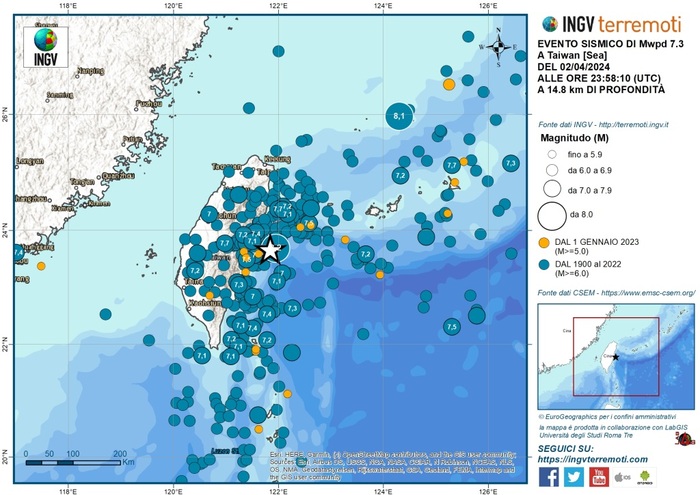Taiwan is held in a vice that periodically triggers large earthquakes such as the 7.4 magnitude one that occurred in the early hours of today. "The island is compressed between the Philippine and Eurasian plates", Carlo Doglioni, president of the National Institute of Geophysics and Volcanology, told ANSA. "The Philippine plate is approaching the Eurasian one at a rate of over 7 centimeters per year. The tremor - says Doglioni - was 30 times stronger than the one recorded in L'Aquila in 2009".
The Eurasia plate pushes eastwards in the opposite direction to that of the Philippines, and the rupture of the fault that generated the strong earthquake occurred along a line that goes from North-East to South-West. For this reason, although commonly represented as precise points on maps, for earthquakes of this size it is more appropriate to speak of slips of a large fault area, extending 60 kilometers long and 35 kilometers wide.
"Generally, these events follow a standard path - says Doglioni - with a stronger first shock followed by aftershocks of lower intensity. The duration of this phenomenon depends on the magnitude of the main earthquake: the stronger it is, the longer it takes for it to fade away the sequence". The first earthquake, which occurred at 1.58 am Italian time, was in fact accompanied by a second shock of magnitude 6.4 which occurred a few minutes later, at 2.11 am, and by many other weaker shocks.
"Events like these happen around fifteen a year in the world, so it is a natural phenomenon", explains the president of the INGV. "The Taiwan area has already been affected by many large earthquakes in the past, even with magnitudes greater than 8, like the one that occurred in 1920." That event reached magnitude 8.2 and occurred a few kilometers east of what happened today.
In the last 50 years, the region has been affected by six other earthquakes with a magnitude greater than 7 and located within 250 kilometers of the last one, as reported by the US Geological Survey USGS: the strongest was that of 1999 (magnitude 7.7), which caused at least 2,300 victims and damages estimated at 14 billion dollars, the location of which is set approximately 59 kilometers east of tonight's earthquake. "In the latter case - adds Doglioni - anti-seismic construction in Taiwan has proven to be very advanced".
Reproduction reserved © Copyright ANSA

